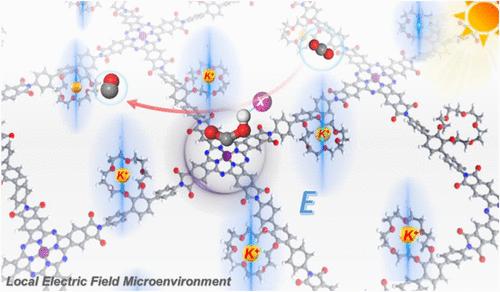Supramolecularly Built Local Electric Field Microenvironment around Cobalt Phthalocyanine in Covalent Organic Frameworks for Enhanced Photocatalysis
IF 15.6
1区 化学
Q1 CHEMISTRY, MULTIDISCIPLINARY
引用次数: 0
Abstract
The local electric field (LEF) plays an important role in the catalytic process; however, the precise construction and manipulation of the electric field microenvironment around the active site remains a significant challenge. Here, we have developed a supramolecular strategy for the implementation of a LEF by introducing the host macrocycle 18-crown-6 (18C6) into a cobalt phthalocyanine (CoPc)-containing covalent organic framework (COF). Utilizing the supramolecular interaction between 18C6 and potassium ion (K+), a locally enhanced K+ concentration around CoPc can be built to generate a LEF microenvironment around the catalytically active Co site. The COF with this supramolecularly built LEF realizes an activity of up to 7.79 mmol mmolCo–1 h–1 in the photocatalytic CO2 reduction reaction (CO2RR), which is a 180% improvement compared to its counterpart without 18C6 units. The effect of LEF can be subtly controlled by fully harnessing the K+@18C6 interaction by changing the potassium salts with different counterions. In situ spectroscopy and density functional theory calculations show that the complexation of K+ by 18C6 creates a positive electric field that stabilizes the critical intermediate *COOH involved in CO2RR, which can be tuned by the halide ion-mediated K+@18C6 interaction and hydrogen-bonding interaction, consequently leading to improved catalytic performance to varying degrees.

共价有机框架中酞菁钴周围超分子构建的局部电场微环境增强光催化作用
局部电场(LEF)在催化过程中发挥着重要作用;然而,如何精确构建和操纵活性位点周围的电场微环境仍然是一项重大挑战。在此,我们开发了一种超分子策略,通过在含酞菁钴(CoPc)的共价有机框架(COF)中引入宿主大环18-冠-6(18C6)来实现局部电场。利用 18C6 与钾离子(K+)之间的超分子相互作用,可以在 CoPc 周围建立局部增强的 K+ 浓度,从而在具有催化活性的 Co 位点周围产生 LEF 微环境。在光催化二氧化碳还原反应(CO2RR)中,具有这种超分子构建的 LEF 的 COF 的活性高达 7.79 mmol mmolCo-1 h-1,与不含 18C6 单元的 COF 相比提高了 180%。通过改变钾盐与不同的反离子,充分利用 K+@18C6 的相互作用,可以巧妙地控制 LEF 的效果。原位光谱和密度泛函理论计算表明,K+与 18C6 的络合会产生一个正电场,从而稳定 CO2RR 所涉及的临界中间体 *COOH,该电场可通过卤化离子介导的 K+@18C6 相互作用和氢键相互作用进行调节,从而在不同程度上提高催化性能。
本文章由计算机程序翻译,如有差异,请以英文原文为准。
求助全文
约1分钟内获得全文
求助全文
来源期刊
CiteScore
24.40
自引率
6.00%
发文量
2398
审稿时长
1.6 months
期刊介绍:
The flagship journal of the American Chemical Society, known as the Journal of the American Chemical Society (JACS), has been a prestigious publication since its establishment in 1879. It holds a preeminent position in the field of chemistry and related interdisciplinary sciences. JACS is committed to disseminating cutting-edge research papers, covering a wide range of topics, and encompasses approximately 19,000 pages of Articles, Communications, and Perspectives annually. With a weekly publication frequency, JACS plays a vital role in advancing the field of chemistry by providing essential research.

 求助内容:
求助内容: 应助结果提醒方式:
应助结果提醒方式:


